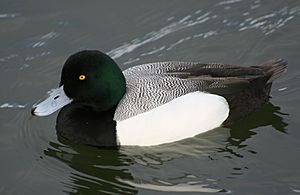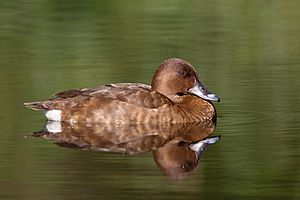Diving duck facts for kids
Quick facts for kids Diving ducks |
|
|---|---|
 |
|
| Greater scaup, Aythya marila | |
| Scientific classification |
|
| Kingdom: | Animalia |
| Phylum: | Chordata |
| Class: | Aves |
| Order: | Anseriformes |
| Family: | Anatidae |
| Subfamily: | Anatinae |
| Tribe: | Aythyini |
| Genera | |
|
Marmaronetta |
|
Diving ducks, also known as pochards or scaups, are a special group of ducks. They get their name because they mostly find their food by diving deep underwater. These ducks are part of a very large bird family called Anatidae, which includes all ducks, geese, and swans.
Even though diving ducks look a bit like dabbling ducks (who feed on the surface), they are actually quite different. Scientists have studied their DNA and found that diving ducks and dabbling ducks are not very closely related. They just happen to have similar features because they live in similar ways, which is called convergent evolution.
You might also hear about sea ducks, like long-tailed ducks or eiders, being called diving ducks. They also dive for food, but they belong to a different group of ducks.
Contents
What Makes Diving Ducks Special?
Diving ducks are found all over the world, but most of them live in the Northern Hemisphere. They are known for their amazing diving skills. They can go deep underwater to catch their meals. However, some types, like the Netta species, don't dive as much and prefer to feed closer to the surface, like dabbling ducks.
These ducks love to be in groups. You'll often see them on fresh water or in estuaries (where rivers meet the sea). The greater scaup even spends its winters in the ocean!
Life as a Diving Duck
Diving ducks are strong fliers. Their wings are broad and blunt, so they have to flap them faster than many other ducks. This also means they need a bit of effort to take off from the water.
Many diving ducks that live in northern areas travel long distances when the seasons change. This is called migration. Ducks from southern areas usually don't migrate. However, the hardhead duck sometimes travels far in search of water, especially when it rains a lot.
Diving ducks don't walk very well on land. Their legs are placed further back on their bodies, which is perfect for helping them swim and dive underwater, but not so great for walking!
Types of Diving Ducks
Scientists group diving ducks into different genera. One unique type is the marbled duck, which is the only member of its genus, Marmaronetta. It seems to be very different from other diving ducks.
The pink-headed duck is another interesting case. It's probably extinct now, but scientists think it might have belonged to the Netta group. DNA studies suggest it was one of the earliest diving ducks to develop.
Here are some of the main groups and examples of diving ducks:
Main Groups of Diving Ducks
- Genus Marmaronetta
- Marbled duck (Marmaronetta angustirostris)
- Genus Netta
- Red-crested pochard (Netta rufina)
- Southern pochard (Netta erythrophthalma)
- Rosy-billed pochard (Netta peposaca)
- Genus Aythya
- Canvasback (Aythya valisineria)
- Common pochard (Aythya ferina)
- Redhead (Aythya americana)
- Ring-necked duck (Aythya collaris)
- Hardhead (Aythya australis)
- Baer's pochard (Aythya baeri)
- Ferruginous duck (Aythya nyroca)
- Madagascar pochard (Aythya innotata) – This duck was thought to be extinct but was found again in 2006!
- New Zealand scaup (Aythya novaeseelandiae)
- Tufted duck (Aythya fuligula)
- Greater scaup (Aythya marila)
- Lesser scaup (Aythya affinis)
See also
 In Spanish: Aythynae para niños
In Spanish: Aythynae para niños


